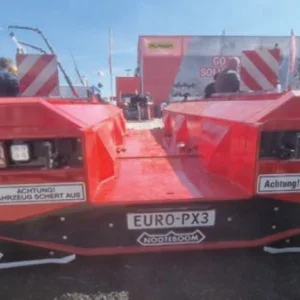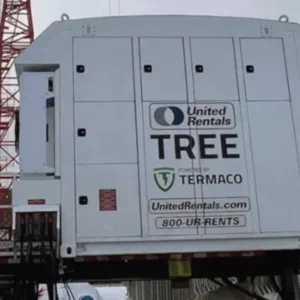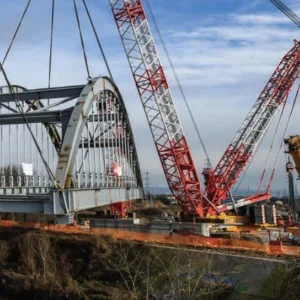Renters are concerned that there does not seem to be a single energy solution, but they know that, with demand sparked by a recovering economy, cranes will be needed.
As of 2010 coal had 44% of the market share with natural gas and nuclear at about 20% each, and combined hydropower and renewables at around 10%.
The US Energy Information Administration is anticipating the change of the energy market.
Authors of the 2012 Annual Energy Outlook expect a decline in coal over the next few years, with an increase nuclear and a large increase in the small fraction now generated by wind power. It has also seen production of natural gas increase in the Southeast.
All’s president Michael Liptak, whose rental company supplies cranes and transport, says he has seen a shift in the energy construction market in North America, in favour of natural gas and nuclear build.
"There is always a demand for energy. What’s changing are the types of energy being developed. The natural resources and fuels for generating power are shifting," says Liptak.
"For electric utilities, power generation by coal is shifting to natural gas. According to some in the electric power industry, new coal-fired capacity is still part of the plan in the next few years — but natural gas is poised to replace coal."
All rents cranes for coal-fired electric power plant retrofits, shale-oil contracts, wind turbine and nuclear power work.
Liptak says, "A coal-fired power plant retrofit could require hundreds of cranes engaged for years, and that includes telescopic forklifts and aerials as well as the larger cranes.
"We have cranes working all over, from ore mining in the Northern US and Canada to shale oil in the Bakken to natural gas drilling in the Marcellus shale formation in the Appalachian Basin."
Helping coalmines in West Virginia upgrade their infrastructures is a major part of All’s work, says Liptak.
It has nonetheless seen a decrease in coal projects because of new Environmental Protection Agency policies aimed at limiting the carbon gas emissions allowed at plants, which are set for each state.
Liptak says, "Regarding Obama’s policies, for example, on cleaning up coal, they do affect our work in coal-mining heavy states like West Virginia, where we have a branch yard. The coal market is slow because of all the new regulations. It’s difficult to sell and ship it overseas now, also."
All, which installs wind turbines in places like Canada and Pennsylvania, is not sure that policymakers will continue to finance contractors throwing up new wind turbines.
"Tax credits for wind turbine construction expire this year, and I don’t know what next year will bring for the wind market," says Liptak. "With the tax credits expiring for windmill construction, we may need to make adjustments in our numbers. "
"But wind energy is still growing, and there will always be maintenance work on windmills that requires cranes."
All recently enlarged the capacity its fleet with the Manitowoc 16000, a 440USt crawler crane with a wind attachment, which it says is a key asset to the wind energy market. Some current nuclear projects also look to be on the upturn, Liptak says. "An upswing in nuclear power plant work would change the dynamic still more. The larger manufacturers are always developing new cranes to suit particular markets, which we can take advantage of when we need to."
One such larger manufacturer is American-headquartered Lampson International. Lampson International builds and rents its own reactor-scale lifting device, the Transi-Lift. Trans-Lift, heavy lift cranes, crawler transport, and specialized nuclear power construction equipment are all part of its energy offerings.
It sees a steady demand for Lampson Transi-Lifts on projects at refineries as well as coal and gas plants around the US.
Doing work on combined cycle plants, coal-fired plants and nuclear power plants, the international company has recently done work in the Rocky Mountain Region, the East, South and Southwest. It says the energy market fortunately escaped some of the worst scrapes of the recession, a time when it too saw increased crane activity in renewable energy construction.
"Obama’s policies of subsidizing green energy give some in our industry a temporary increase in activity," says Kate Lampson of Lampson International.
"On the other hand Obama’s restrictive policies of real energy, i.e. coal, gas, nuclear, XL Pipeline, moratorium on drilling, and failure to properly fund the spent fuel storage site in Nevada, have a highly restrictive effect on our industry as a whole and we will all suffer as a result."
Worldwide, as well as US, markets continue to provide work for Transi-lifts. "We have had good penetration in the Asian market and we have continuing discussions with potential clients in the Asia, Eastern Europe, and Europe Proper for work in the nuclear industry.
"In addition, we also had market penetration for heavy transportation in Asia."
Frank Bardonaro, president of Maxim Crane says the company is renting cranes for energy-related work in coal, gas and nuclear. He finds that all terrains and rough terrains can be particularly useful for energy work in remote places.
"In the fleet mix we have a lot of all terrains and rough terrains. We have one of the largest crawler cranes in North America, so our fleet mix has evolved with more large rough terrains and mid- to larger all terrains."
"By the nature of their work, they are in some pretty remote areas that require a lot of logistics between multiple sites so even when crawler cranes are suited for a specific site, it is not always economically feasible to move a crawler crane that distance. While you would think the rough terrain would be the natural solution for the rugged terrain, you tend to see all terrains in those situations as they need higher capacity."
The size of equipment used for power plant work is going up, but that means the cost of procuring and maintaining the fleet increases too.
Bardonaro says, "I think the biggest difference post-recession is that the cranes are more expensive than they were five or six years ago, but the rental rates that people are getting are not any higher. I think from a market standpoint the rates for equipment haven’t moved up even though the costs of buying and managing have."
"From the equipment-needs standpoint, every year equipment just keeps getting bigger. One of the things we have seen in the last 10 years is larger and larger picks. Another thing we are seeing in the market is a lot of the customers are requiring a younger fleet and they’re also requiring higher insurance.
"In the long run commercial needs usually win out, whether that means that coal is more economical than wind or wind is more economical than gas."






